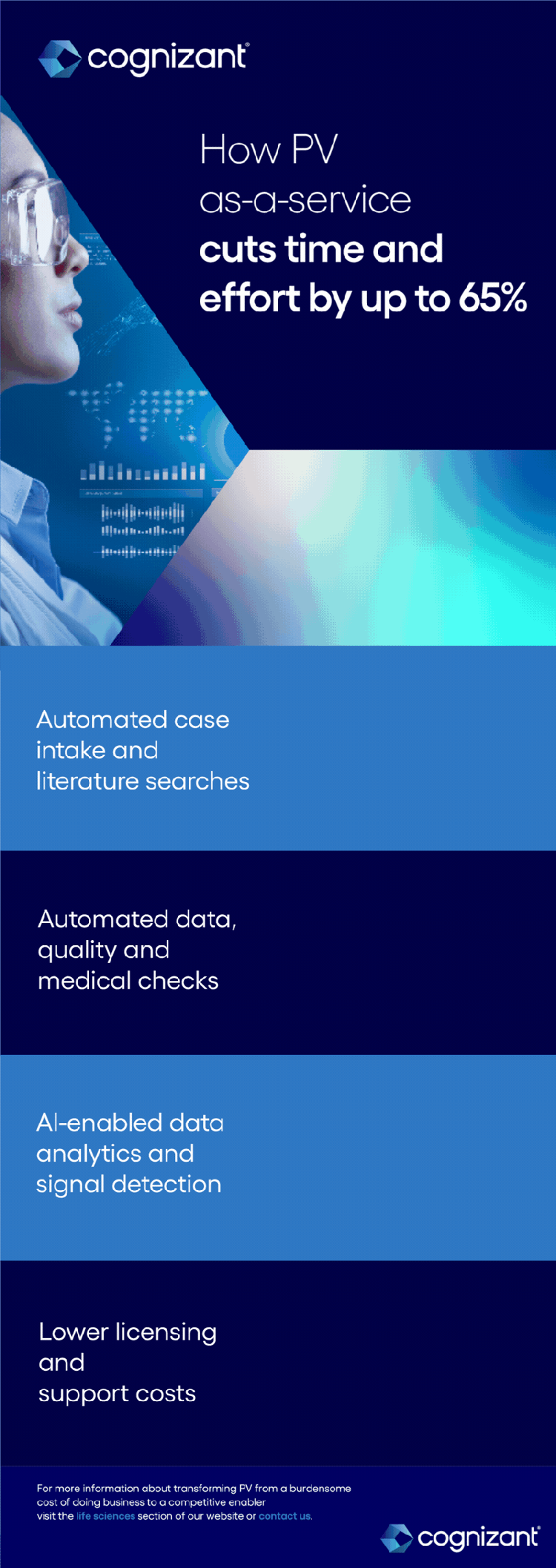
Turn pharmacovigilance from a cost center into a competitive advantage styles-h2 text-white
<p><span class="medium"><br>May 04, 2022</span></p>
Turn pharmacovigilance from a cost center into a competitive advantage
<p><b>Four best practices for using PV as-a-service to deliver drugs more quickly and at lower cost.</b></p>
<p>Imagine you’re in the corporate boardroom of a large pharmaceutical company. You might hear about cost pressures—brought on by new, niche competitors—and the increased need for faster delivery of more drugs and personal treatments. As the conversation continues, the subject might turn to cost centers, those business functions needed by any life sciences company to meet complex global safety regulations and satisfy public concerns about treatment safety.</p> <p><a href="https://www.who.int/teams/regulation-prequalification/regulation-and-safety/pharmacovigilance" target="_blank">Pharmacovigilance</a> (PV)—which monitors adverse drug effects—has traditionally been viewed as one of those cost centers. Because PV is typically characterized by manual, disconnected processes that are costly, expensive and slow, this function has historically diverted money and staff away from developing quality treatments. In effect, it pulls the focus away from the patient in an era when patient-centricity is key.</p> <p>But perhaps what really needs fixing isn’t just the pharmacovigilance function itself, but rather those boardroom conversations: Pharmacovigilance isn’t merely a cost center, but an untapped source of competitive advantage. By taking PV processes out of the data center and away from manual, siloed groups—and combining these processes on a single cloud-based service—life sciences companies can automate case intake, processing, reporting, signal detection and risk management. We’ve seen organizations cut costs by as much as 65% and reduce case processing times by 60% by taking this approach.</p>

#
<p><br> Additionally, these life sciences companies are in a position to gain competitive advantage by:</p> <ul> <li>Enabling trial participants, sponsors, partners and regulators to rapidly share data and workflows<br> <br> </li> <li>More easily identifying adverse reactions that happen less frequently<br> <br> </li> <li>Opening opportunities to repurpose drugs for additional uses<br> <br> </li> <li>Reducing licensing and infrastructure costs</li> </ul> <h4>How to optimize cloud-based pharmacovigilance</h4> <p>Through our work with clients, we’ve identified four essential ways to realize the benefits of running pharmacovigilance on a cloud platform, using an as-a-service model:</p> <h5><b><i>1</i>.</b> Ease platform integration.</h5> <p>Pharmacovigilance as-a-service makes it easier to exchange data among the separate systems dedicated to functions like case intake, case processing and the management of signals and risk. By integrating these functions through platform-supplied mechanisms like the E2B standard and extract-transform-load, life sciences companies can eliminate or significantly reduce costs and delays because they no longer need to do this integration themselves or maintain separate technology stacks and vendors for each step in the process. </p> <p>In this integration process, it’s best to keep customizations, and the additional testing that accompanies it, to a minimum to realize the optimal cost and time savings.</p> <h5><b><i>2</i>.</b> Leverage secure cloud hosting.</h5> <p>Secure cloud hosting not only cuts costs and enables scalability; it also ensures organizations properly secure sensitive patient data and the company’s intellectual property. The PV as-a-service platform should be hosted in a GxP (good practice) environment, with secure VPN tunnel-enabled access for organizations with appropriate firewall measures. All servers hosting customer data should have secure VPN access only and relevant security measures, such as anti-virus and encryption for data at rest and in transit.</p> <p>The company itself still needs to establish proper recovery point objectives and recovery time objectives (RPO/RTO) that the cloud provider must meet in case of a system outage. </p> <h5><b><i>3</i>.</b> Maximize ease of use.</h5> <p>To ensure the cloud-based pharmacovigilance platform is easy to deploy and use, it should have an intuitive user interface for regulatory reporting, signal management and risk management, as well as well-organized training, self-learning modules and recorded training for users to access at their convenience. </p> <p>Specialized service providers can help deliver an intuitive user interface, as well as educate non-technical staff on the reasons for the new processes and how they’ll help them do their jobs. Such providers can also provide support at a global enterprise level to train staff in all modules of the PV solution, in all the languages a company’s users speak, and explain how it can help meet regulatory requirements in every geography in which the pharma operates.</p> <h5><b><i>4</i>.</b> Tap into artificial intelligence/machine learning capabilities.</h5> <p>By using artificial intelligence/machine learning, robotic process automation, and natural language processing and generation, pharma companies can get a real boost from their PV as-a-service solution. AI/ML can automate functions such as case processing, literature database searches, identification and extraction of unstructured content such as caregivers’ notes, report formatting to meet regulatory requirements and estimations of various signals’ potential impacts. </p> <p>We estimate that the use of AI/ML can eliminate 50% to 60% of manual pharmacovigilance effort, from case intake to reporting.</p> <p>For example, AI/ML can automate the intelligent classification and extraction of unstructured and structured text from medical narratives and provide flexible rule-based frameworks for data handling to facilitate case intake, reporting and signal detection.</p> <h4>The future of pharmacovigilance</h4> <p>Faced with rising drug development costs and increased competition, pharma companies can no longer afford to run their PV processes as a cost center. To rapidly deliver safe, affordable and effective treatments that are focused on patient needs, forward-looking businesses will turn to cloud-based PV as-a-service platforms that uncover new insights into delivering drugs that help more patients at scale.</p> <p><i>This article was written by Venu Mallarapu and Aditya Mahajan, Senior Director and Associate Director R&D Solutions respectively with Cognizant’s Life Sciences Practice.</i></p> <p><i>For more information about transforming pharmacovigilance from a burdensome cost of doing business to a competitive enabler, visit the <a href="/content/cognizant-dot-com/us/en/industries/life-sciences-technology-solutions.html" target="_blank" rel="noopener noreferrer">life sciences</a> section of our website or <a href="/content/cognizant-dot-com/us/en/about-cognizant/contact-us.html" target="_blank" rel="noopener noreferrer">contact us</a>.</i></p>
<p>We’re here to offer you practical and unique solutions to today’s most pressing technology challenges. Across industries and markets, get inspired today for success tomorrow.</p>
